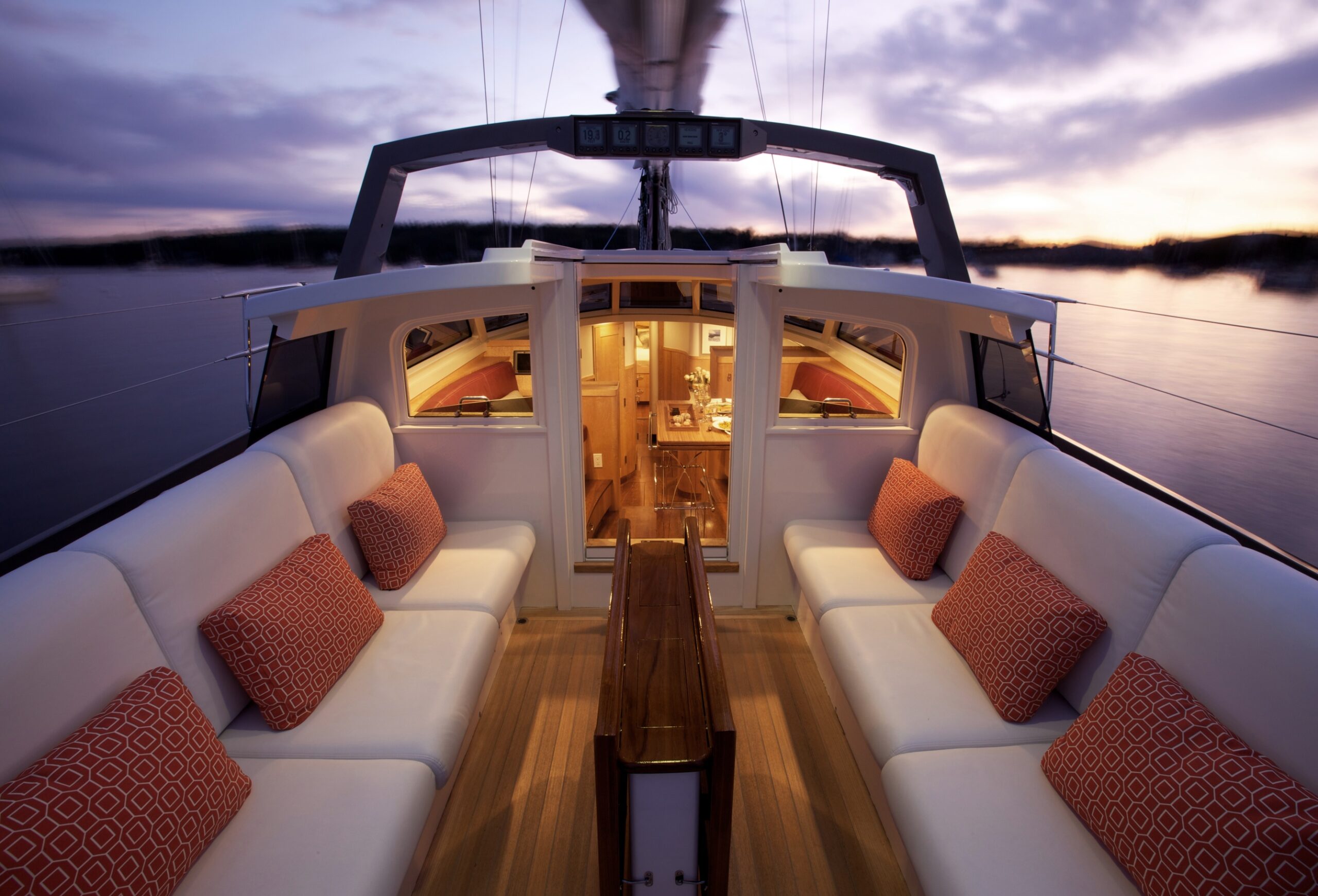From offices to homes, cell phones to appliances, we live in an era of expecting more from everything. A modern car is more than a means of transportation from point A to point B. It’s an entertainment center, massage parlor, babysitter, navigator, mobile office, and increasingly a personal chauffeur.
The expectation to do more with less is omnipresent, and when it comes to the interior design of a yacht, this is no exception. Designers must increasingly meet consumers’ desires to live intentionally, work dynamically, rest restoratively, and play immersively.
While packing this growing list of demands into a home is challenging enough to fit this all in a space able to navigate seas and storms, voyage to distant locals, and endure exposure to every type of extreme climate imaginable is no small task. While mega-yacht designers have the luxury of working with thousands of square feet, small and medium-sized yachts must apply an added level of creativity and innovation to check all the boxes in a much smaller space and more efficient solutions.
As we head into 2025, we’re exploring the top emerging trends shaping yacht interiors and how they cater to the modern mariner’s needs.
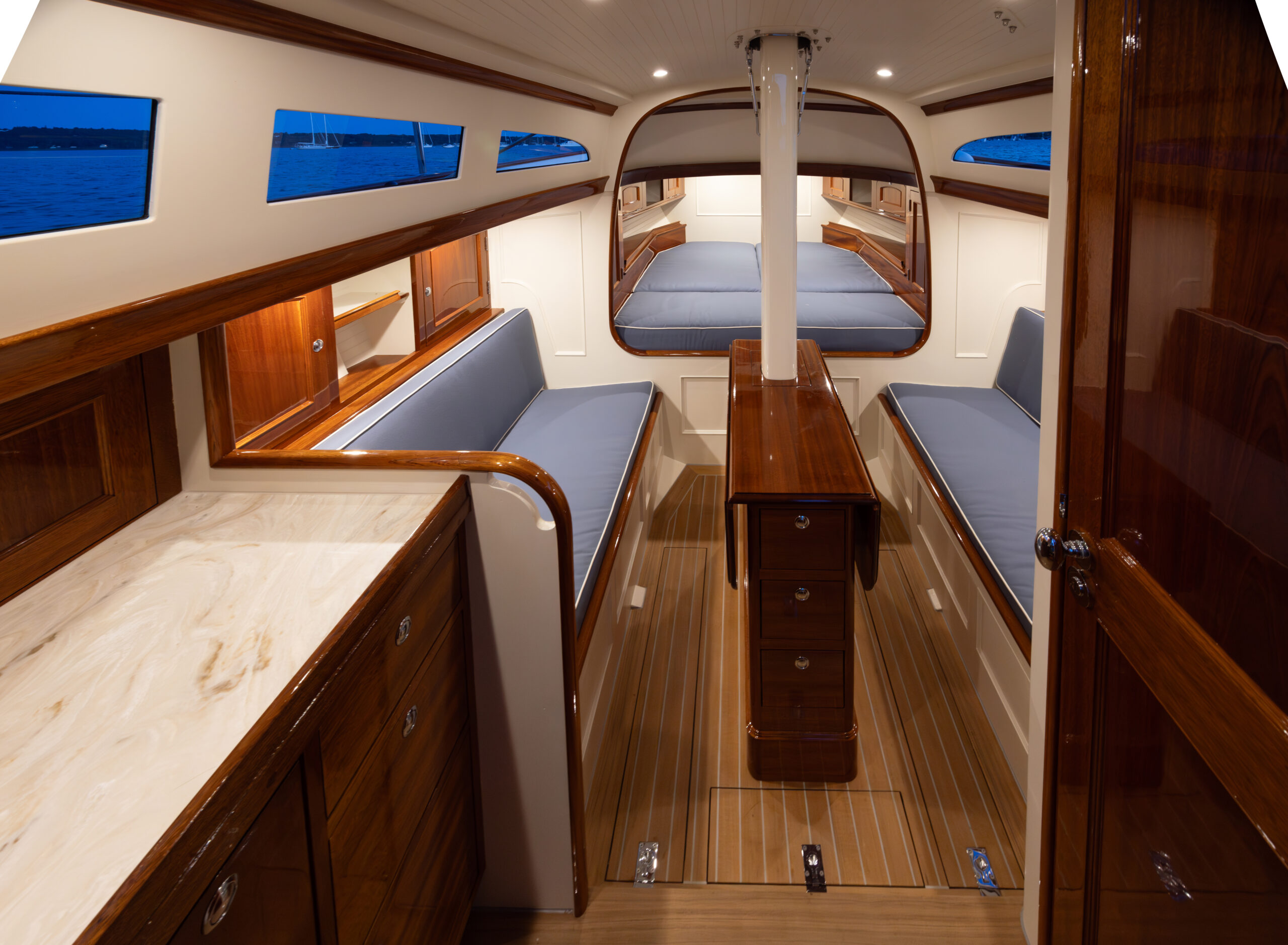
There is a growing trend to do more with limited space by packing in clean and elegant design features that allow spaces to provide a multitude of roles. 39-ft WISP. Designed by Stephens Waring. Built by Artisan Boatworks. Photo Credit Alison Langley.
1. Doing More with Less
Bigger is not always better for interior spaces. There is a growing trend to do more with limited space by packing in clean and elegant design features that allow spaces to provide a multitude of roles. While folding tables and beds, underfloor storage, and creative shelving have long been a part of yacht interior design, the execution has often been clunky and utilitarian. Increasingly, there is a push to make each space look elegant and thoughtful regardless of the configuration. Electing for a smaller space frees up additional budget for high-end materials, including wood joinery, textiles, and lighting.
Designers are integrating innovative technology, such as TV screens that slide out of concealed spaces on retractable fixtures. Smart system controls allow lighting, temperature, and entertainment systems to be managed from a single interface, reducing the need for wall-mounted controls and adding to the clean, minimal aesthetic.
Working with compact spaces has always been the Achilles heel aboard a smaller yacht, designers have increasingly found tricks to make certain areas feel more comfortable. Like, arranging the enclosed head towards the yacht’s center finds taller headroom and opportunities for larger windows and ventilation. A galley can be optimized for functional operation by emphasizing the most critical components, including large countertops with efficient drawer refrigeration.
2. Natural and Sustainable Materials
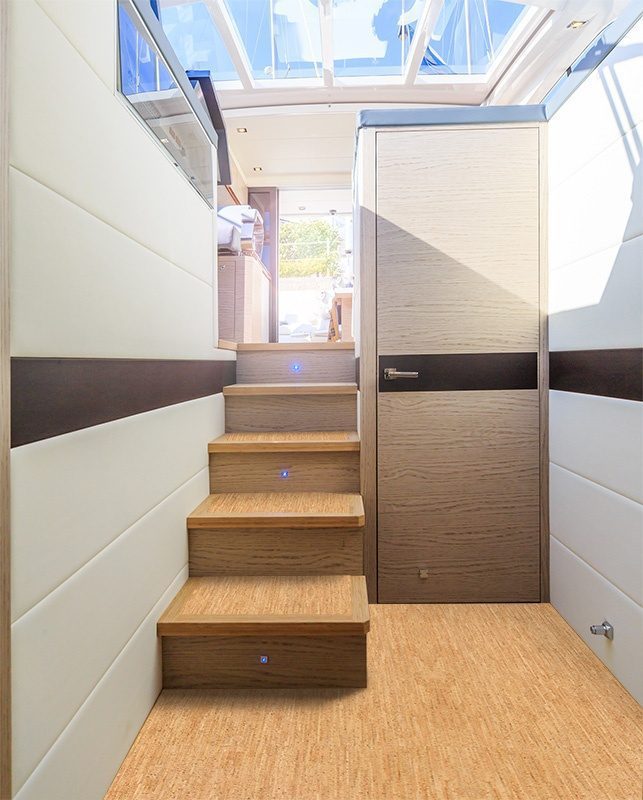
Sustainable woods like bamboo, reclaimed teak, and cork are eco-friendly but also have a unique aesthetic appeal. Photo courtesy of iCork Floor (icorkfloor.com)
Sustainable woods like bamboo, reclaimed teak, and cork are eco-friendly but also have a unique aesthetic appeal. Cork is a standout sustainable material due to its renewability, carbon sequestration, durability, and versatility. Harvested from cork oak trees without harming them, cork regenerates every 9–12 years, promoting healthier growth and enabling trees to live for up to 200 years. This regenerative harvesting also helps these trees act as carbon sinks, making cork production potentially carbon-negative.
Bamboo is another increasingly popular choice for interior design due to its sustainability, durability, and aesthetic appeal. Highly renewable, bamboo grows rapidly—reaching maturity in just 3–5 years—without the need for pesticides or fertilizers. Known for its strength, bamboo resists warping, cracking, and swelling, making it ideal for high-traffic areas, flooring, furniture, and cabinetry. Its lightweight yet resilient structure provides versatility across various applications, while its natural, minimalist look brings warmth and a modern, earthy feel to interiors.
Cork and bamboo (when properly sealed) are naturally resistant to moisture and mold, providing surprisingly good long-term durability and minimal maintenance.
3. Raised Salon Connecting Indoor and Outdoor Living
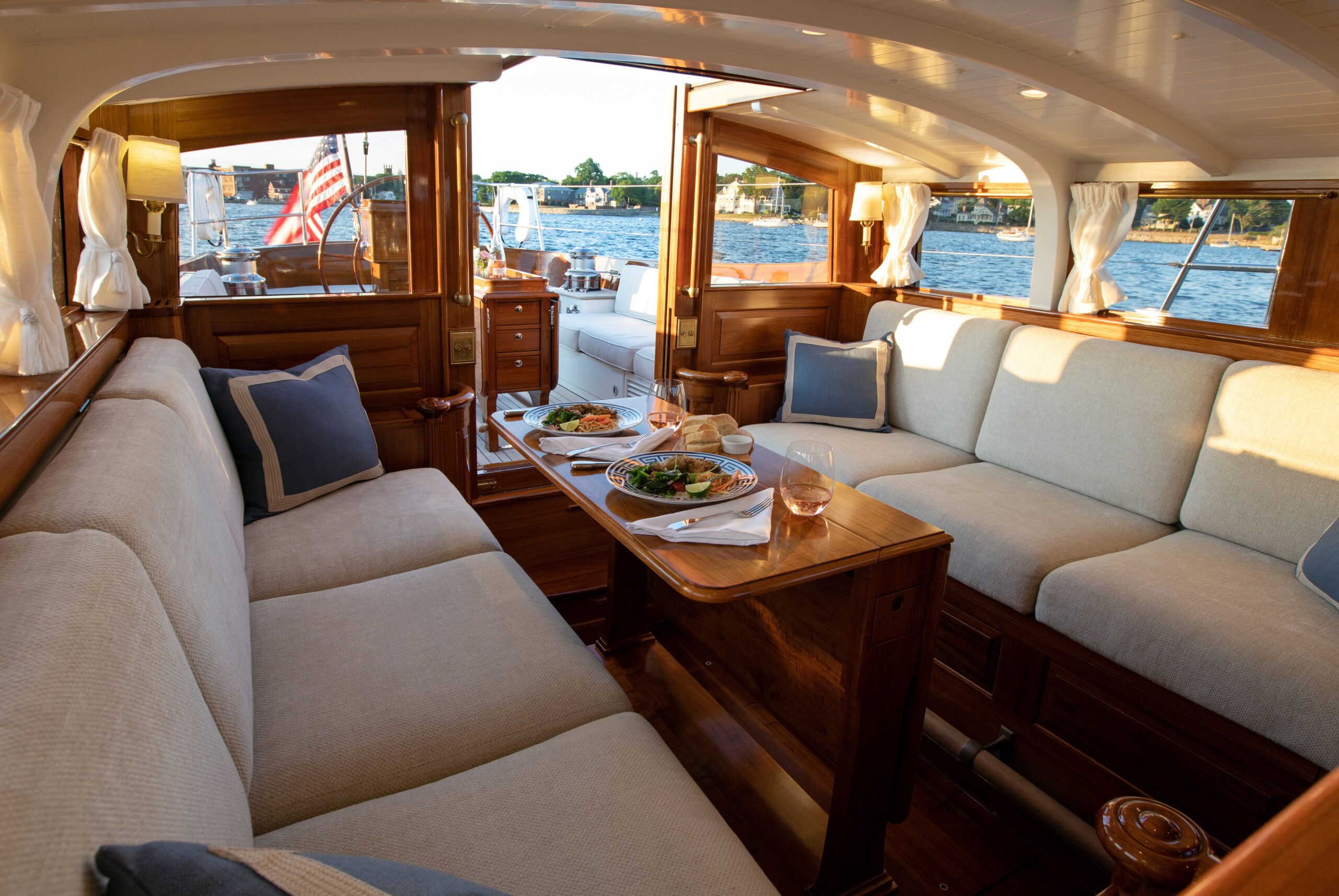
A well-designed raised salon provides a seamless transition from full outdoor experience to full protection. 65-ft ANNA. Designed by Stephens Waring. Built by Lyman-Morse. Photo Credit Alison Langley
Traditional aft-cockpit sailboats can be delightful to sail, creating an enjoyable open-air experience with great visibility. But the overarching problem is the all-or-nothing nature of the layout: when open-air stops being pleasant, whether it’s darkness or cold or fog or the dreaded mosquitoes, to gain shelter, you need to abandon the airy outdoors and descend a deep companionway into the belly of the boat, giving up the views and the communication with anyone who stays topside and trading ultimate coziness for ultimate airiness.
A well-designed raised salon provides the best of all worlds. When this ergonomic dance is done right, the result is a seamless transition from full outdoor experience to full protection. If sun or breeze becomes too much for the cockpit, slide forward into protection behind the superstructure. Still too exposed? Duck into the saloon and sit aft on the settee with a drop window down to remain in touch with the sailing crew while sheltered from wind, sun or water.
4. Enhanced Connectivity and Entertainment
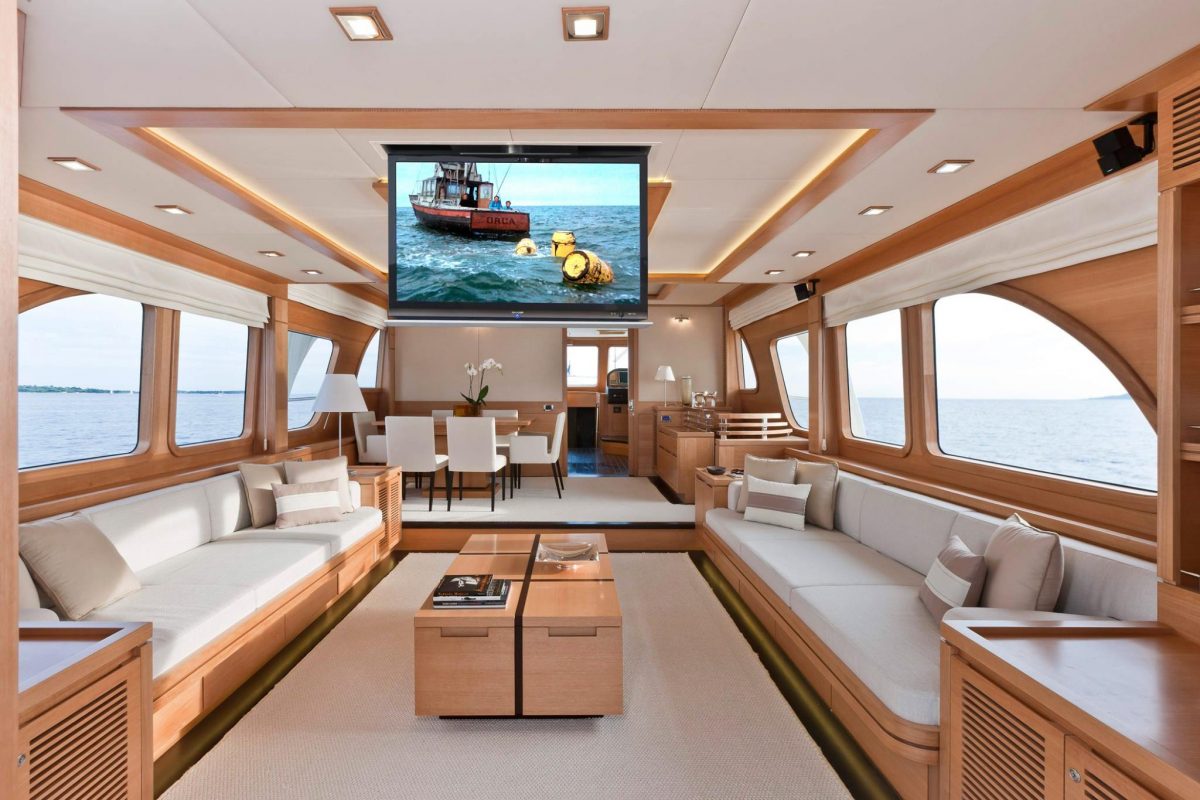
Ultalift Retractable TV saves spaces and adds additional functionality to interior spaces. (ultraliftaustralia.com.au)
The need to stay connected and work from anywhere is no longer a luxury but a necessity. Modern yachts, big and small, incorporate high-speed internet, advanced communication systems, and entertainment platforms enabling occupants to stay connected with the outside world. This seamless integration of technology means that work can continue even while enjoying the tranquility of the ocean. Starlink, in particular, has made access to high-speed internet cost-effective, enabling blazing communication and entertainment and ushering in a new era of remote “work-from-sea” opportunities.
The design priority is to incorporate technology and entertainment systems discreetly and blend into the design aesthetic. Technology offers a great interior enhancement, but it shouldn’t be the star of the show. Drop-down monitors, counter-integrated wireless device charging stations, and central control systems maintain a clean aesthetic while packing plenty of tech punch.
5. Family-Centric Designs Open Floor Plans
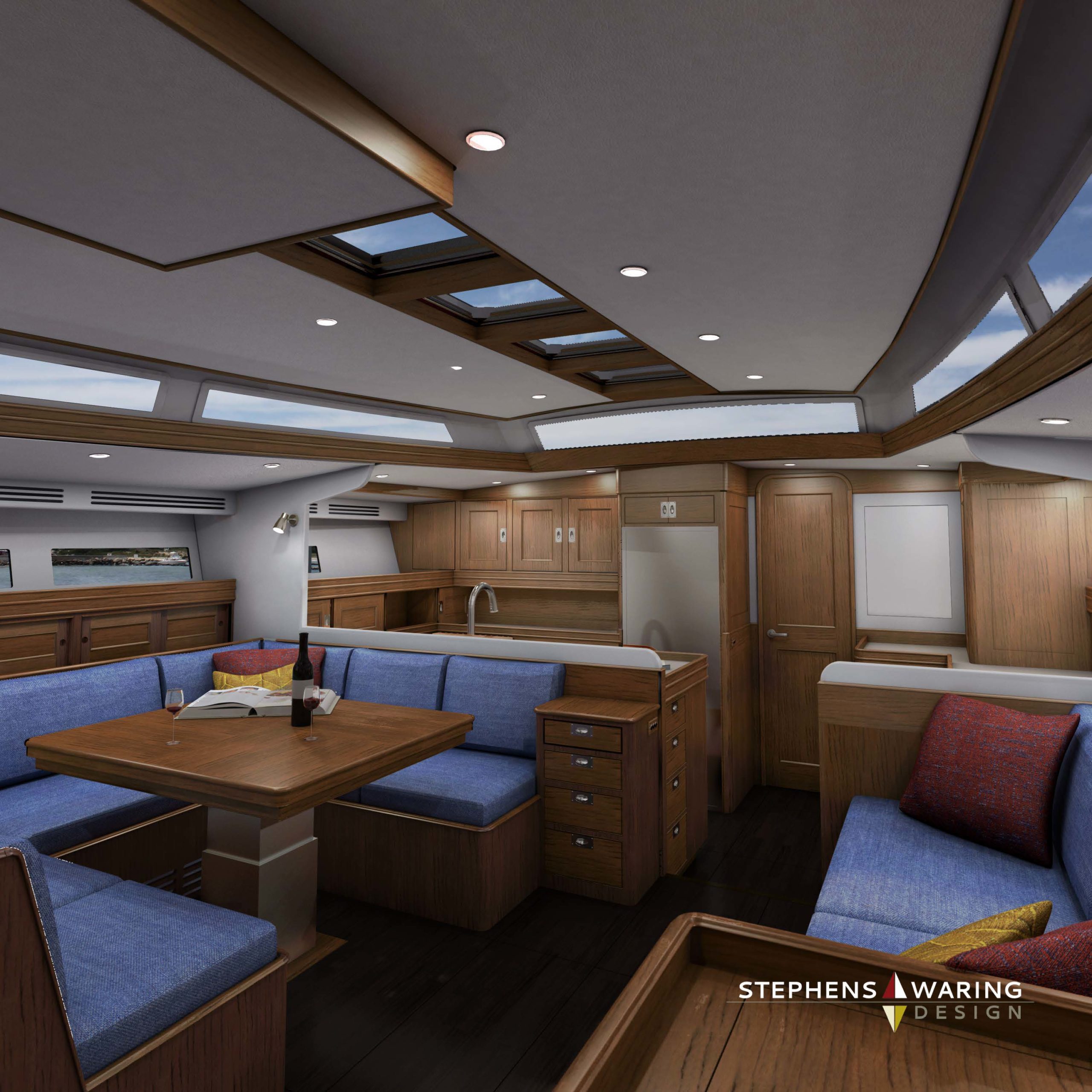
Large open salons promote easy movement between spaces, making areas feel larger and more interconnected. 68-ft CIRRUS. Designed by Stephens Waring. Built by James Bett Enterprises. Photo Credit Alison Langley.
Today’s yachts are designed with families and friends in mind, featuring customizable spaces that cater to diverse interests and age groups. Multi-purpose areas allow for activities ranging from family movie nights to elegant dinner parties.
Large open salons promote easy movement between spaces, making areas feel larger and more interconnected. Furthermore, with fewer walls blocking light, natural sunlight can spread more freely throughout the space and deeper into the yacht. This not only lowers the risk of motion sickness but also leads to brighter interiors, which can improve mood and reduce the need for artificial lighting, improving connectivity between interior and exterior environments.
Ventilation is also crucial on a yacht, where closed compartments can quickly feel stuffy. Open layouts enable air to circulate freely, reducing the need for mechanical ventilation, improving comfort for guests, and enhancing the appeal of spending longer periods on water.
6. Minimalism Meets Warmth
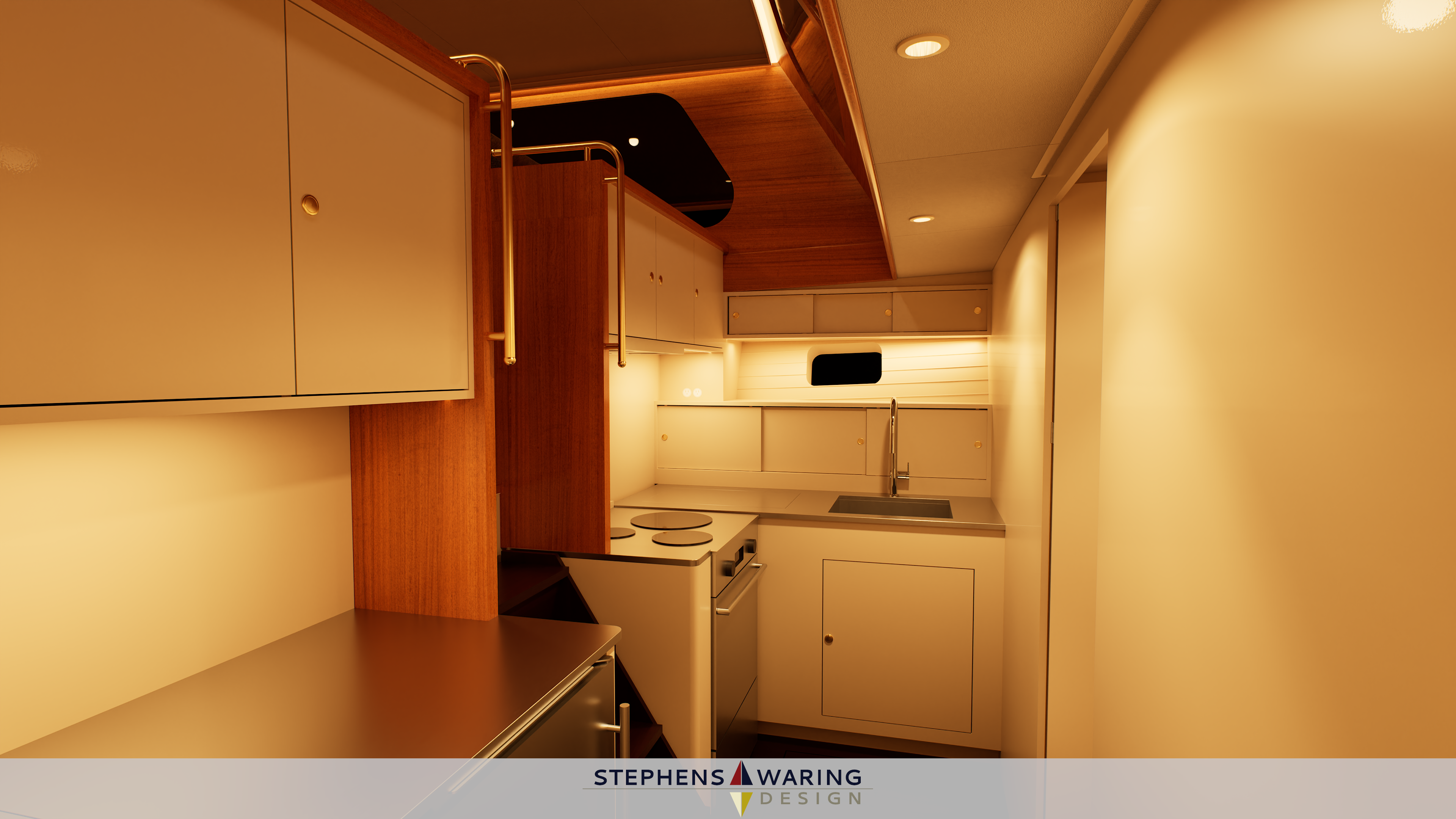
Minimalism and warmth are no longer opposites in interior design; instead, they’re being seamlessly integrated to create inviting, uncluttered spaces that feel both serene and comfortable. Interior design of IROQUIS by Stephens Waring.
Minimalism and warmth are no longer opposites in interior design; instead, they’re being seamlessly integrated to create inviting, uncluttered spaces that feel both serene and comfortable. This approach, sometimes called “warm minimalism,” focuses on simplicity and functionality while incorporating elements that make a space feel lived-in and cozy.
Wood is at the heart of warm minimalism, especially species with warm undertones like oak, walnut, teak, and cedar. Wooden floors, furniture, or accent walls introduce organic texture and a soft, inviting color palette. Materials like copper, bronze, wool, and linen also bring warmth through their earthy tones and tactile quality, transforming minimalist interiors from cold and sterile to cozy and approachable.
Warm minimalism often favors a neutral palette but with a twist: instead of stark white, you’ll find shades of beige, taupe, sand, and terracotta. These earthy colors add warmth without overpowering the space, making the design feel calm and harmonious.
7. Heritage and Artisanal Craftsmanship
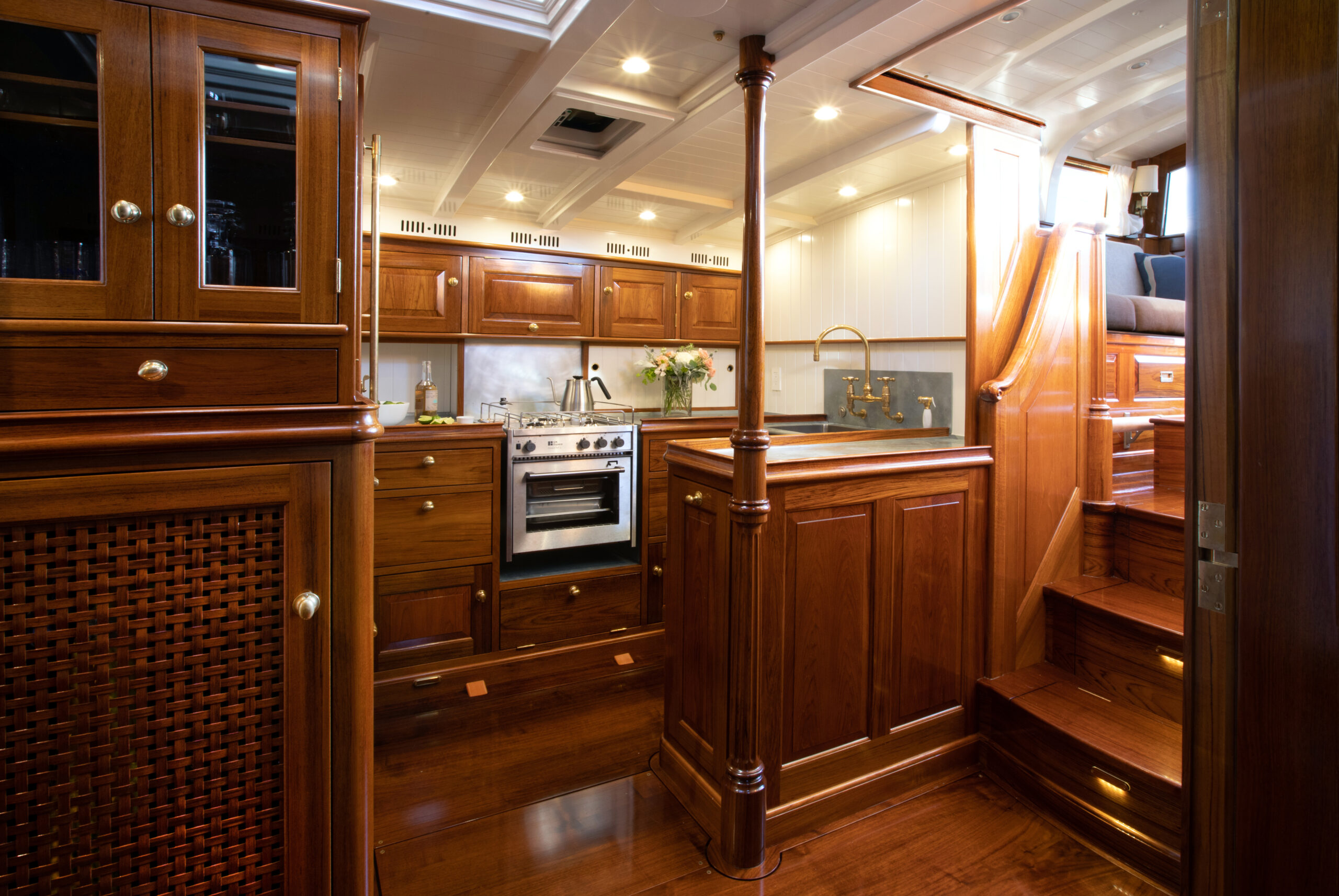
With heritage and artisanal craftsmanship, yacht interiors are transformed into spaces that tell a personal story. 65-ft ANNA, Designed by Stephens Waring. Built by Lyman-Morse. Photo Credit Alison Langley
A revival of traditional craftsmanship is taking center stage, with designers drawing inspiration from local artisanal techniques and historical architecture. With heritage and artisanal craftsmanship, yacht interiors are transformed into spaces that tell a personal story, becoming more than just luxury vessels. Each bespoke item, from a carved dining table to a handwoven rug, becomes part of a curated narrative that reflects the owner’s tastes, values, and travels.
This approach creates an intimate, home-like atmosphere on the yacht, making it not only a vessel for exploration but also a cherished retreat filled with personal meaning.
Modern gadgets and home systems are integrated subtly, with a preference for smart systems devices that blend seamlessly into furniture and decor, preserving the vintage feel without sacrificing modern functionality.
8. Midcentury Influences
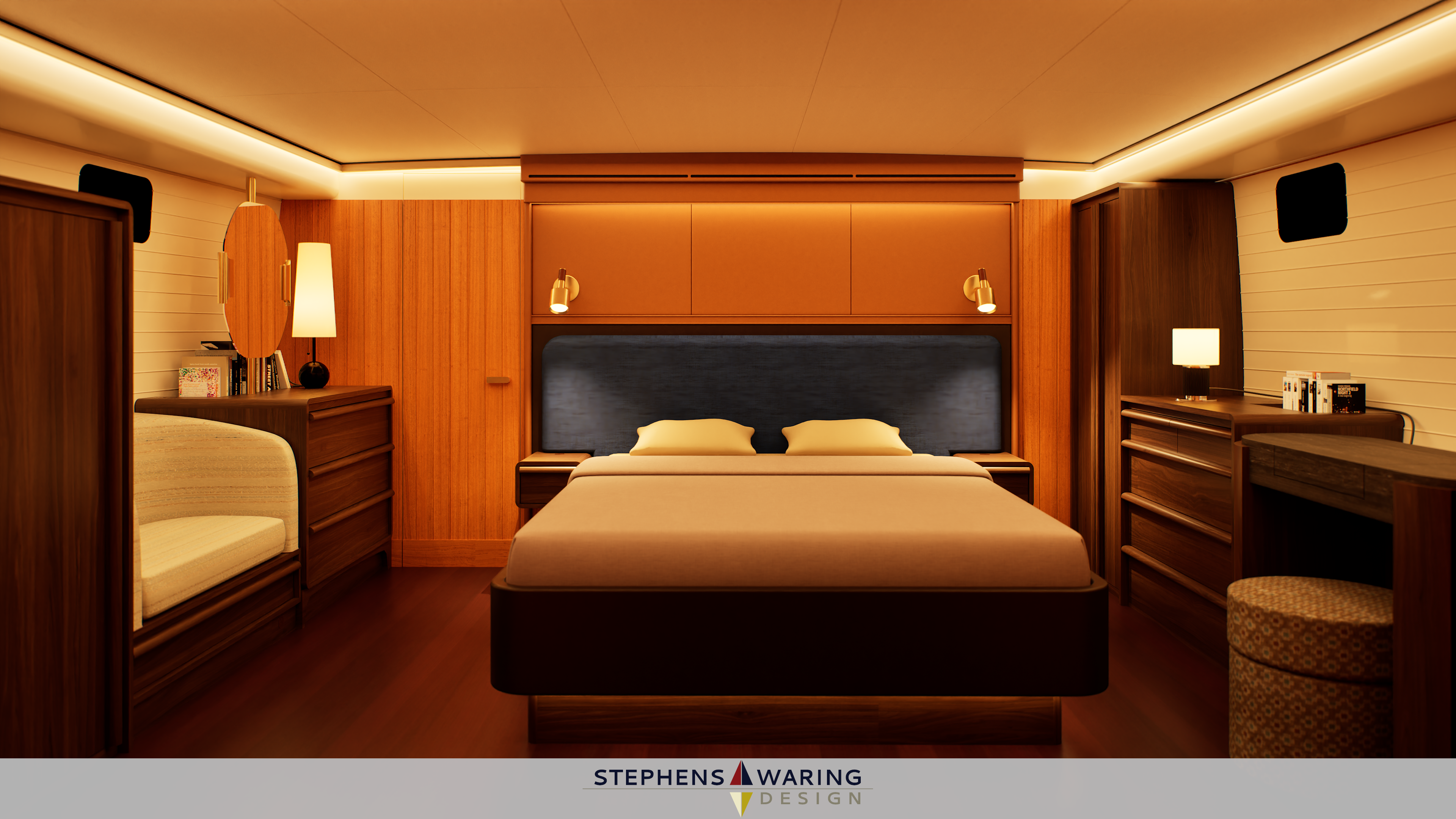
By mixing retro pieces with contemporary design, yacht interiors gain character and a sense of nostalgia. Interior design of IROQUIS by Stephens Waring.
The integration of mid-century elements remains a strong theme. By mixing retro pieces with contemporary design, yacht interiors gain character and a sense of nostalgia. This blend of old and new can create a warm, inviting atmosphere that feels both luxurious and personal. The hallmark of mid-century design is characterized by simple, unadorned lines and organic shapes. Furnishings often feature tapered legs and streamlined profiles, with pieces that appear almost sculptural. This minimalist approach resonates, especially in smaller spaces where clean lines contribute to a sense of openness.
Wood, leather, and stone are at the forefront, emphasizing quality craftsmanship and an eco-friendly approach. Mid-century’s affinity for natural materials aligns well with the current focus on sustainable design, as designers in 2025 seek out responsibly sourced, long-lasting materials that offer a natural, warm aesthetic.
Conclusion:
The integration of compact yet functional interiors, sustainable materials, and advanced technologies ensures that yachts can serve as multifunctional spaces, from work environments to family-friendly havens, even in remote locations. Yet as design pushes the boundaries of innovation and advancement, there remains a strong calling to celebrate the past and nostalgia for a simpler way of life.
